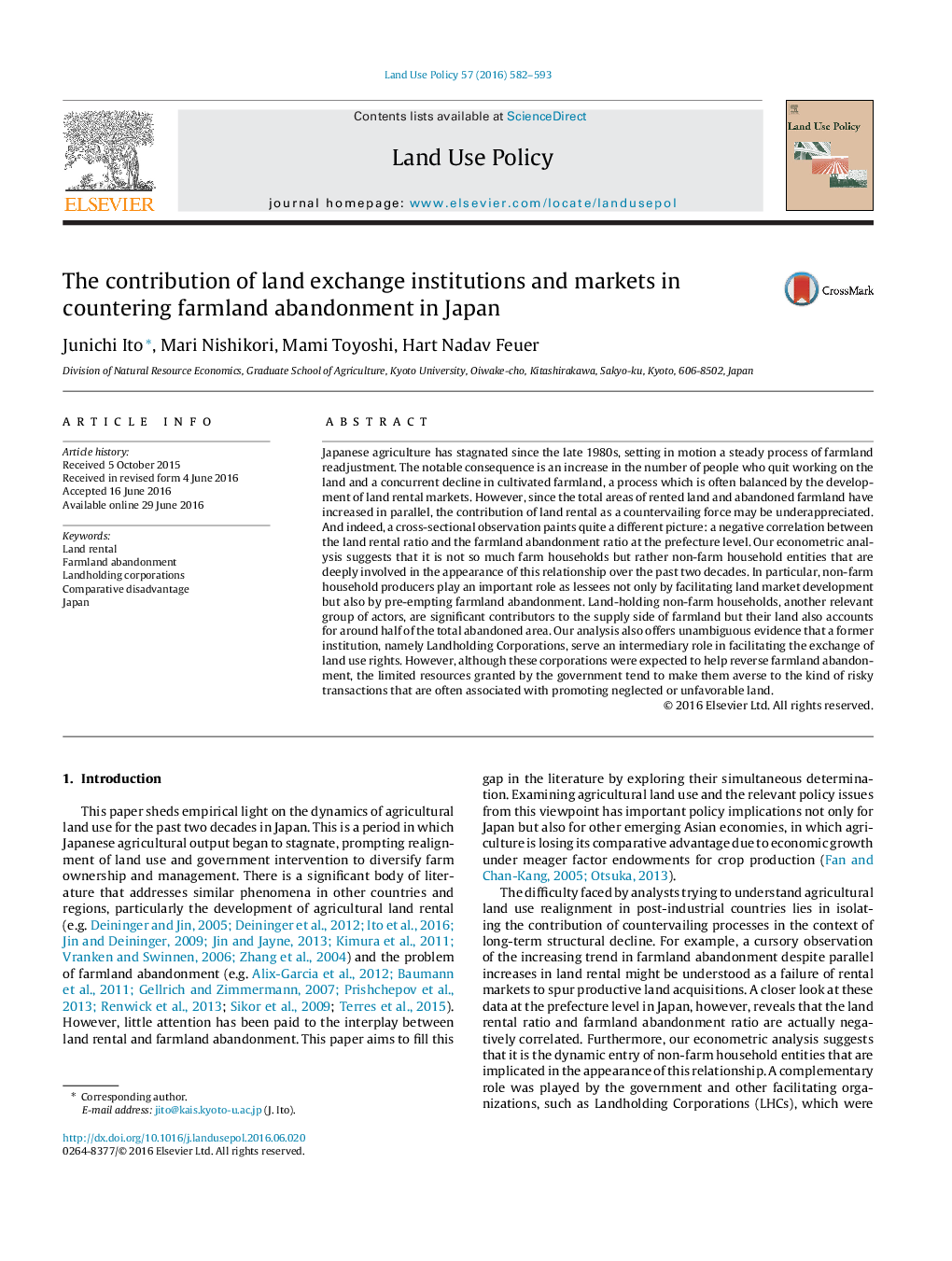| کد مقاله | کد نشریه | سال انتشار | مقاله انگلیسی | نسخه تمام متن |
|---|---|---|---|---|
| 6547098 | 160091 | 2016 | 12 صفحه PDF | دانلود رایگان |
عنوان انگلیسی مقاله ISI
The contribution of land exchange institutions and markets in countering farmland abandonment in Japan
ترجمه فارسی عنوان
سهم نهادهای مبادله زمین و بازار در مقابله با رها کردن زمین های کشاورزی در ژاپن
دانلود مقاله + سفارش ترجمه
دانلود مقاله ISI انگلیسی
رایگان برای ایرانیان
کلمات کلیدی
اجاره زمین، رها کردن زمین کشاورزی، شرکت های مالکیت زمین، معایب تطبیقی. ژاپن،
ترجمه چکیده
کشاورزی ژاپن از اواخر دهه 1980 رکود یافته است و روند مداوم اصلاحات کشاورزی را در پیش گرفته است. پیامد قابل توجه این است که افزایش تعداد افرادی که از کار بر روی زمین رها شده اند و کاهش همزمان زمین های زراعی که فرآیندی است که اغلب با توسعه بازار اجاره زمین متعادل است. با این حال، از آنجا که کلیه زمین های اجاره شده و زمین های رها شده به طور موازی افزایش یافته است، سهم اجاره زمین به عنوان یک نیروی مخالف ممکن است کم اهمیت باشد. و در واقع، مشاهده مقطعی یک تصویر کاملا متفاوت را نشان می دهد: یک رابطه منفی بین نسبت اجاره زمین و نسبت رها کردن زمین های کشاورزی در سطح ریاست. تجزیه و تحلیل اقتصاد سنجی ما نشان می دهد که خانواده های مزرعه ای نه چندان زیادی، بلکه نهاد های غیر کشاورزی، عمیقا در ظهور این رابطه در دو دهه گذشته حضور دارند. به طور خاص، تولیدکنندگان خانگی غیر کشاورزی، نقش مهمی در اجارهنشینها دارند، نه تنها با تسهیل توسعه بازار زمین، بلکه همچنین پیشگیری از ریزش زمینهای کشاورزی. خانواده های غیر کشاورزی مزرعه، یکی دیگر از گروه های ذیربط بازیگران، همکاری قابل توجهی در زمینه عرضه زمین های کشاورزی دارند، اما زمین آنها نیز حدود نیمی از کل منطقه محروم را تشکیل می دهد. تجزیه و تحلیل ما همچنین مدرکی را ارائه می دهد که یک موسسه سابق، یعنی شرکت های مالکیت زمین، نقش مهمی در تسهیل تبادل حقوق استفاده از زمین ها ایفا می کند. با این حال، اگر چه انتظار می رود این شرکت ها به معکوس کردن رها کردن زمین های کشاورزی کمک کنند، منابع محدودی که توسط دولت اعطا می شود، تمایل دارند که آنها را به نوعی از معاملات خطرناک که اغلب با ارتقاء زمین های نادیده گرفته شده یا نامطلوب مرتبط است، مخالفت کنند.
موضوعات مرتبط
علوم زیستی و بیوفناوری
علوم کشاورزی و بیولوژیک
جنگلداری
چکیده انگلیسی
Japanese agriculture has stagnated since the late 1980s, setting in motion a steady process of farmland readjustment. The notable consequence is an increase in the number of people who quit working on the land and a concurrent decline in cultivated farmland, a process which is often balanced by the development of land rental markets. However, since the total areas of rented land and abandoned farmland have increased in parallel, the contribution of land rental as a countervailing force may be underappreciated. And indeed, a cross-sectional observation paints quite a different picture: a negative correlation between the land rental ratio and the farmland abandonment ratio at the prefecture level. Our econometric analysis suggests that it is not so much farm households but rather non-farm household entities that are deeply involved in the appearance of this relationship over the past two decades. In particular, non-farm household producers play an important role as lessees not only by facilitating land market development but also by pre-empting farmland abandonment. Land-holding non-farm households, another relevant group of actors, are significant contributors to the supply side of farmland but their land also accounts for around half of the total abandoned area. Our analysis also offers unambiguous evidence that a former institution, namely Landholding Corporations, serve an intermediary role in facilitating the exchange of land use rights. However, although these corporations were expected to help reverse farmland abandonment, the limited resources granted by the government tend to make them averse to the kind of risky transactions that are often associated with promoting neglected or unfavorable land.
ناشر
Database: Elsevier - ScienceDirect (ساینس دایرکت)
Journal: Land Use Policy - Volume 57, 30 November 2016, Pages 582-593
Journal: Land Use Policy - Volume 57, 30 November 2016, Pages 582-593
نویسندگان
Junichi Ito, Mari Nishikori, Mami Toyoshi, Hart Nadav Feuer,
